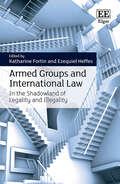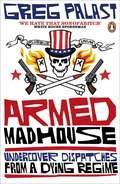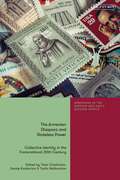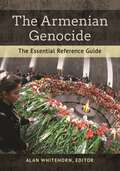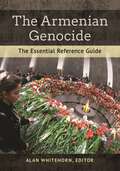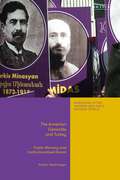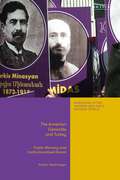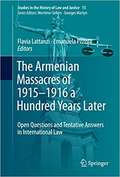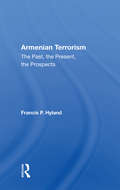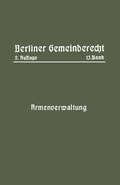- Table View
- List View
Armed Drones and the Ethics of War: Military virtue in a post-heroic age (War, Conflict and Ethics)
by Christian EnemarkThis book assesses the ethical implications of using armed unmanned aerial vehicles (‘hunter-killer drones’) in contemporary conflicts. The American way of war is trending away from the heroic and towards the post-heroic, driven by a political preference for air-powered management of strategic risks and the reduction of physical risk to US personnel. The recent use of drones in the War on Terror has demonstrated the power of this technology to transcend time and space, but there has been relatively little debate in the United States and elsewhere over the embrace of what might be regarded as politically desirable and yet morally worrisome: risk-free killing. Arguably, the absence of a relationship of mutual risk between putative combatants poses a fundamental challenge to the status of war as something morally distinguishable from other forms of violence, and it also undermines the professional virtue of the warrior as a courageous risk-taker. This book considers the use of armed drones in the light of ethical principles that are intended to guard against unjust increases in the incidence and lethality of armed conflict. The evidence and arguments presented indicate that, in some respects, the use of armed drones is to be welcomed as an ethically superior mode of warfare. Over time, however, their continued and increased use is likely to generate more challenges than solutions, and perhaps do more harm than good. This book will be of much interest to students of the ethics of war, airpower, counter-terrorism, strategic studies and security studies in general.
Armed Forces in Law Enforcement Operations? - The German and European Perspective
by Kim Eduard LioeAt the center of this study lies the allocation of responsibilities and the division of labor between the armed forces and the mission of the police as well as other security forces in Europe. The mission of these forces defines the demarcation line between the spheres of internal and external security by assigning the former to the police and the latter to the armed forces. The focal idea is the evaluation of the feasibility of a strict separation as maintained in Germany in a European context, practical difficulties in its application, and potential ways to overcome such difficulties. This comprises in particular a comparison of the "German Way" with other European states and the corresponding methods chosen against the background of joint operations abroad.
Armed Groups and International Law: In the Shadowland of Legality and Illegality
Through its careful consideration of the status of armed groups within a complex legal landscape, this insightful book identifies and examines the tensions that arise due to their actions existing across a spectrum of legality and illegality. Considering the number of armed groups currently exercising governance functions and controlling territory and population in the world, its analysis is especially topical. Armed Groups and International Law provides essential peer-reviewed analyses of the place of armed groups in the legal framework. A collaborative effort between eminent scholars from different disciplines, it summarises various points of contention within the study of these armed actors, detailing examples that are highly relevant to the contemporary world, such as Afghanistan and Syria. Addressing law-making, rebel governance and accountability, this illuminating book will be of great benefit to students of international humanitarian law, human rights law, international criminal law, and public international law seeking to expand their understanding of the treatment of armed groups within the international legal system. It will also serve as a useful resource for practitioners working in the area of civilian protection and academics conducting research on armed conflict from a variety of disciplines.
Armed Madhouse: Undercover Dispatches from a Dying Regime
by Greg Palast‘Razor sharp research … shows why every US citizen should be quaking in their boots’ Metro, Books of the Year ‘Bill Hicks with a press pass’ The ListAward-winning guerrilla journalist Greg Palast has gone where most have been too scared to unearth the ugly truth about the haves and have-mores who rule our world … America. Here he reports from behind enemy lines to reveal just how bad it’s got in a dangerous regime: how elections are bought and free speech comes at a price. How citizens are ruled by fear. And how our brave new globalized world means the poor get hammered, while corporations silently buy up the planet. It’s not pretty – but it’s all true … ‘Palast is one of the few journalists writing who has both the anger and the wit to offer himself up as a persuasive – and more importantly, readable – voice of the left’ Observer‘A rollercoaster ride from Baghdad to New Orleans and Osama bin Laden’s cave to the back rooms of the Pentagon’ Big Issue ‘Very funny … For anyone who thinks that no-one from the US knows what’s going on, Palast is the perfect riposte’ Guardian
Armed Non-State Actors in International Humanitarian and Human Rights Law: Foundation and Framework of Obligations, and Rules on Accountability
by Konstantinos MastorodimosThe accountability of armed non-state actors is a neglected field of international law, overtaken by the regimes of state responsibility and individual criminal accountability as well as fears of legitimacy. Yet armed non-state actors are important players in the international arena and their activities have significant repercussions. This book focuses on their obligations and accountability when they do not function as state agents, regardless of the existence or extent of accountability of their individual members. The author claims that their distinct features lead to their classification into three different types: de facto entities, armed non-state actors in control of territory, and common article 3 armed non-state actors. The mechanisms that trigger the applicability of humanitarian and human rights law regimes are examined in detail as well as the framework of obligations. In both cases, the author argues that armed non-state actors should not be treated as entering international law and process exclusively through the state. The study concludes by focussing on their accountability in international humanitarian and human rights law and, more specifically, to the rules of attribution, remedies and reparations for violations of their primary obligations.
Armed Non-State Actors in International Humanitarian and Human Rights Law: Foundation and Framework of Obligations, and Rules on Accountability
by Konstantinos MastorodimosThe accountability of armed non-state actors is a neglected field of international law, overtaken by the regimes of state responsibility and individual criminal accountability as well as fears of legitimacy. Yet armed non-state actors are important players in the international arena and their activities have significant repercussions. This book focuses on their obligations and accountability when they do not function as state agents, regardless of the existence or extent of accountability of their individual members. The author claims that their distinct features lead to their classification into three different types: de facto entities, armed non-state actors in control of territory, and common article 3 armed non-state actors. The mechanisms that trigger the applicability of humanitarian and human rights law regimes are examined in detail as well as the framework of obligations. In both cases, the author argues that armed non-state actors should not be treated as entering international law and process exclusively through the state. The study concludes by focussing on their accountability in international humanitarian and human rights law and, more specifically, to the rules of attribution, remedies and reparations for violations of their primary obligations.
Armed Resistance
by Don PendletonWhen the Oval Office needs covert rapid response to avert disaster, Stony Man gets the call. Handpicked, the best of the best in cyber-intelligence and commando warfare, this elite squad fights by a code of duty and dedication to holding the line between the free world and violent extremists.
Armed Robbers: Identity and Cultural Mythscapes in the Lucky Country (Clarendon Studies in Criminology)
by Emmeline TaylorNotoriously difficult to access, armed robbers have mostly eluded the attempts of authors to access their lives. Aside from biographies of the most infamous, the stories of armed robbers, as varied, bizarre, and captivating as they are, have rarely been told. This has resulted in robbers being considered as largely homogenous; their unique pathways to crime ignored or lumped into ill-defined stereotypes. Yet their routes into one of the most serious violent crimes could not be more varied. Written by a leading female criminologist, Armed Robbers relays the powerful, sometimes amusing, often harrowing stories of 42 convicted criminals in Australia. Their accounts are interwoven with historical events and national folk tales - colonial settlement, convict ancestry, gold rushes, and a sometimes-ferocious hyper-masculinity born of frustration and constructed in forgotten towns - each contribute threads that when sewn together produce a uniquely Australian criminal identity.
Armed Robbers: Identity and Cultural Mythscapes in the Lucky Country (Clarendon Studies in Criminology)
by Emmeline TaylorNotoriously difficult to access, armed robbers have mostly eluded the attempts of authors to access their lives. Aside from biographies of the most infamous, the stories of armed robbers, as varied, bizarre, and captivating as they are, have rarely been told. This has resulted in robbers being considered as largely homogenous; their unique pathways to crime ignored or lumped into ill-defined stereotypes. Yet their routes into one of the most serious violent crimes could not be more varied. Written by a leading female criminologist, Armed Robbers relays the powerful, sometimes amusing, often harrowing stories of 42 convicted criminals in Australia. Their accounts are interwoven with historical events and national folk tales - colonial settlement, convict ancestry, gold rushes, and a sometimes-ferocious hyper-masculinity born of frustration and constructed in forgotten towns - each contribute threads that when sewn together produce a uniquely Australian criminal identity.
The Armenian Diaspora and Stateless Power: Collective Identity in the Transnational 20th Century (Armenians in the Modern and Early Modern World)
by Talar Chahinian, Sossie Kasbarian and Tsolin NalbantianFrom genocide, forced displacement, and emigration, to the gradual establishment of sedentary and rooted global communities, how has the Armenian diaspora formed and maintained a sense of collective identity? This book explores the richness and magnitude of the Armenian experience through the 20th century to examine how Armenian diaspora elites and their institutions emerged in the post-genocide period and used “stateless power” to compose forms of social discipline. Historians, cultural theorists, literary critics, sociologists, political scientists, and anthropologists explore how national and transnational institutions were built in far-flung sites from Istanbul, Aleppo, Beirut and Jerusalem to Paris, Los Angeles, and the American mid-west. Exploring literary and cultural production as well as the role of religious institutions, the book probes the history and experience of the Armenian diaspora through the long 20th century, from the role of the fin-de-siècle émigré Armenian press to the experience of Syrian-Armenian asylum seekers in the 21st century. It shows that a diaspora's statelessness can not only be evidence of its power, but also how this “stateless power” acts as an alternative and complement to the nation-state.
The Armenian Diaspora and Stateless Power: Collective Identity in the Transnational 20th Century (Armenians in the Modern and Early Modern World)
From genocide, forced displacement, and emigration, to the gradual establishment of sedentary and rooted global communities, how has the Armenian diaspora formed and maintained a sense of collective identity? This book explores the richness and magnitude of the Armenian experience through the 20th century to examine how Armenian diaspora elites and their institutions emerged in the post-genocide period and used “stateless power” to compose forms of social discipline. Historians, cultural theorists, literary critics, sociologists, political scientists, and anthropologists explore how national and transnational institutions were built in far-flung sites from Istanbul, Aleppo, Beirut and Jerusalem to Paris, Los Angeles, and the American mid-west. Exploring literary and cultural production as well as the role of religious institutions, the book probes the history and experience of the Armenian diaspora through the long 20th century, from the role of the fin-de-siècle émigré Armenian press to the experience of Syrian-Armenian asylum seekers in the 21st century. It shows that a diaspora's statelessness can not only be evidence of its power, but also how this “stateless power” acts as an alternative and complement to the nation-state.
The Armenian Experience: From Ancient Times to Independence
by Gaïdz MinassianArmenian national identity has long been associated with what has come to be known as the Armenian Genocide of 1915. Immersing the reader in the history, culture and politics of Armenia – from its foundations as the ancient kingdom of Urartu to the modern-day Republic – Gaïdz Minassian moves past the massacres embedded in the Armenian psyche to position the nation within contemporary global politics. An in-depth study of history and memory, The Armenian Experience examines the characteristics and sentiments of a national identity that spans the globe. Armenia lies in the heart of the Caucasus and once had an empire – under the rule of Tigranes the Great in the first century BC – that stretched from the Caspian to the Mediterranean seas. Beginning with an overview of Armenia's historic position at the crossroads between Rome and Persia, Minassian details invasions from antiquity to modern times by Arabs, Mongols, Ottomans, Persians and Russians right up to its Soviet experience, and drawing on Armenia's post-Soviet conflict with Azerbaijan in its attempts to reunify with the disputed territory of Nagorno-Karabakh. This book questions an Armenian self-identity dominated by its past and instead looks towards the future. Gaïdz Minassian emphasises the need to recognise that the Armenian story began well before the Genocide 1915, and continues as an on-going modern narrative.
The Armenian Experience: From Ancient Times to Independence
by Gaïdz MinassianArmenian national identity has long been associated with what has come to be known as the Armenian Genocide of 1915. Immersing the reader in the history, culture and politics of Armenia – from its foundations as the ancient kingdom of Urartu to the modern-day Republic – Gaïdz Minassian moves past the massacres embedded in the Armenian psyche to position the nation within contemporary global politics. An in-depth study of history and memory, The Armenian Experience examines the characteristics and sentiments of a national identity that spans the globe. Armenia lies in the heart of the Caucasus and once had an empire – under the rule of Tigranes the Great in the first century BC – that stretched from the Caspian to the Mediterranean seas. Beginning with an overview of Armenia's historic position at the crossroads between Rome and Persia, Minassian details invasions from antiquity to modern times by Arabs, Mongols, Ottomans, Persians and Russians right up to its Soviet experience, and drawing on Armenia's post-Soviet conflict with Azerbaijan in its attempts to reunify with the disputed territory of Nagorno-Karabakh. This book questions an Armenian self-identity dominated by its past and instead looks towards the future. Gaïdz Minassian emphasises the need to recognise that the Armenian story began well before the Genocide 1915, and continues as an on-going modern narrative.
The Armenian Genocide: Evidence from the German Foreign Office Archives, 1915-1916
by Wolfgang GustIn 1915, the Armenians were exiled from their land, and in the process of deportation 1.5 million of them were killed. The 1915-1916 annihilation of the Armenians was the archetype of modern genocide, in which a state adopts a specific scheme geared to the destruction of an identifiable group of its own citizens. Official German diplomatic documents are of great importance in understanding the genocide, as only Germany had the right to report day-by-day in secret code about the ongoing genocide. The motives, methods, and after-effects of the Armenian Genocide echoed strongly in subsequent cases of state-sponsored genocide. Studying the factors that went into the Armenian Genocide not only gives us an understanding of historical genocide, but also provides us with crucial information for the anticipation and possible prevention of future genocides.
The Armenian Genocide: The Essential Reference Guide
by Alan WhitehornWith its analytical introductory essays, more than 140 individual entries, a historical timeline, and primary documents, this book provides an essential reference volume on the Armenian Genocide.The Armenian Genocide has often been considered a template for subsequent genocides and is one of the first genocides of the 20th century. As such, it holds crucial historical significance, and it is critically important that today's students understand this case study of inhumanity. This book provides a much-needed, long-overdue reference volume on the Armenian Genocide. It begins with seven introductory analytical essays that provide a broad overview of the Armenian Genocide and then presents individual entries, a historical timeline, and a selection of documents.This essential reference work covers all aspects of the Armenian Genocide, including the causes, phases, and consequences. It explores political and historical perspectives as well as the cultural aspects. The carefully selected collection of perspective essays will inspire critical thinking and provide readers with insight into some of the most controversial and significant issues of the Armenian Genocide. Similarly, the primary source documents are prefaced by thoughtful introductions that will provide the necessary context to help students understand the significance of the material.
The Armenian Genocide: The Essential Reference Guide
by Alan WhitehornWith its analytical introductory essays, more than 140 individual entries, a historical timeline, and primary documents, this book provides an essential reference volume on the Armenian Genocide.The Armenian Genocide has often been considered a template for subsequent genocides and is one of the first genocides of the 20th century. As such, it holds crucial historical significance, and it is critically important that today's students understand this case study of inhumanity. This book provides a much-needed, long-overdue reference volume on the Armenian Genocide. It begins with seven introductory analytical essays that provide a broad overview of the Armenian Genocide and then presents individual entries, a historical timeline, and a selection of documents.This essential reference work covers all aspects of the Armenian Genocide, including the causes, phases, and consequences. It explores political and historical perspectives as well as the cultural aspects. The carefully selected collection of perspective essays will inspire critical thinking and provide readers with insight into some of the most controversial and significant issues of the Armenian Genocide. Similarly, the primary source documents are prefaced by thoughtful introductions that will provide the necessary context to help students understand the significance of the material.
The Armenian Genocide and Turkey: Public Memory and Institutionalized Denial (Armenians in the Modern and Early Modern World)
by Hakan SeckinelginHow is official denial of the Armenian genocide maintained in Turkey? In this book, Hakan Seckinelgin investigates the mechanisms by which denial of the events of 1915 are reproduced in official discourse, and the effect this has on Turkish citizens. Examining state education, media discourse, academic publications, as well as public events debating the Armenian genocide, the book argues that, at the public level, there exists a 'grammar' or 'repertoire' of denial in Turkey which regulates how the issue can be publicly conceptualised and understood. The book's careful analysis examines the way that knowledge about the genocide is censored in Turkey, from the language that must be used to publicly discuss it, to the complex way in which selective knowledge and erased history is reproduced, from 1915 and subsequent generations until today. It argues that denialism has become important to a certain kind Turkish national identity and belonging – and suggests ways in which this relationship can be unpicked in future.
The Armenian Genocide and Turkey: Public Memory and Institutionalized Denial (Armenians in the Modern and Early Modern World)
by Hakan SeckinelginHow is official denial of the Armenian genocide maintained in Turkey? In this book, Hakan Seckinelgin investigates the mechanisms by which denial of the events of 1915 are reproduced in official discourse, and the effect this has on Turkish citizens. Examining state education, media discourse, academic publications, as well as public events debating the Armenian genocide, the book argues that, at the public level, there exists a 'grammar' or 'repertoire' of denial in Turkey which regulates how the issue can be publicly conceptualised and understood. The book's careful analysis examines the way that knowledge about the genocide is censored in Turkey, from the language that must be used to publicly discuss it, to the complex way in which selective knowledge and erased history is reproduced, from 1915 and subsequent generations until today. It argues that denialism has become important to a certain kind Turkish national identity and belonging – and suggests ways in which this relationship can be unpicked in future.
Armenian History and the Question of Genocide
by M. GunterAn analysis of the Turkish position regarding the Armenian claims of genocide during World War I and the continuing debate over this issue, the author offers an equal examination of each side's historical position. The book asks "what is genocide?" and illustrates that although this is a useful concept to describe such evil events as the Jewish Holocaust in World War II and Rwanda in the 1990s, the term has also been overused, misused, and therefore trivialized by many different groups seeking to demonize their antagonists and win sympathetic approbation for them. The author includes the Armenians in this category because, although as many as 600,000 of them died during World War I, it was neither a premeditated policy perpetrated by the Ottoman Turkish government nor an event unilaterally implemented without cause. Of course, in no way does this excuse the horrible excesses committed by the Turks.
The Armenian Massacres of 1915–1916 a Hundred Years Later: Open Questions and Tentative Answers in International Law (Studies in the History of Law and Justice #15)
by Flavia Lattanzi Emanuela PistoiaThis peer-reviewed book features essays on the Armenian massacres of 1915-1916. It aims to cast light upon the various questions of international law raised by the matter. The answers may help improve international relations in the region. In 1915-1916, roughly a million and a half Armenians were murdered in the territory of the Ottoman Empire, which had been home to them for centuries. Ever since, a dispute between Armenians and Turkey has been ongoing over the qualification of the massacres. The contributors to this volume examine the legal nature and consequences of this event. Their investigation strives to be completely neutral and technical. The essays also look at the broader issue of denial. For instance, in Turkey, public speech on the matter can still trigger criminal prosecution whereas in other European States denial of genocide, war crimes and crimes against humanity is criminalized. However, the European Court of Human Rights views criminal prosecution of denial of the Armenian massacres as unlawful. In addition, one essay considers a state’s obligation to remember by looking at lessons learnt from the Inter-American Court of Human Rights. Another contributor looks at a collective right to remember and some ideas to move forward towards a solution. Moreover, the book explores the way the Armenian massacres have affected the relationship between Turkey and the European Union.
Armenian Terrorism: The Past, The Present, The Prospects
by Francis P HylandArising seemingly out of nowhere, Armenian terrorist groups in the last two decades have carried out over 200 attacks in some two dozen countries around the world. Although this wave of terror at first appears to have sprung up without warning, a closer look at Armenian history, especially since World War I, shows that it is only the most recent in a series of outbreaks of ethnic violence. In this study, the author examines the social and political background of Armenian terrorism and its similarities to and differences from other terrorist movements, and he carefully dissects the organizational methods of these groups. An important feature of the work is an extensive and detailed chronology of Armenian terrorism from 1915 to the present. Each entry provides essential information concerning the date and time of the attack, location, victims, weapons used, terrorist groups and individual commandos responsible for the attack, and a list of sources for further reference. A resource for specialists studying terrorism and ethnic violence, "Armenian Terrorism" should also be useful to those interested in the tragic and difficult history of Armenia and Turkey.
Armenian Terrorism: The Past, The Present, The Prospects
by Francis P HylandArising seemingly out of nowhere, Armenian terrorist groups in the last two decades have carried out over 200 attacks in some two dozen countries around the world. Although this wave of terror at first appears to have sprung up without warning, a closer look at Armenian history, especially since World War I, shows that it is only the most recent in a series of outbreaks of ethnic violence. In this study, the author examines the social and political background of Armenian terrorism and its similarities to and differences from other terrorist movements, and he carefully dissects the organizational methods of these groups. An important feature of the work is an extensive and detailed chronology of Armenian terrorism from 1915 to the present. Each entry provides essential information concerning the date and time of the attack, location, victims, weapons used, terrorist groups and individual commandos responsible for the attack, and a list of sources for further reference. A resource for specialists studying terrorism and ethnic violence, "Armenian Terrorism" should also be useful to those interested in the tragic and difficult history of Armenia and Turkey.
The Armenians of Aintab: The Economics of Genocide in an Ottoman Province
by Ümit KurtA Turk’s discovery that Armenians once thrived in his hometown leads to a groundbreaking investigation into the local dynamics of genocide. Ümit Kurt, born and raised in Gaziantep, Turkey, was astonished to learn that his hometown once had a large and active Armenian community. The Armenian presence in Aintab, the city’s name during the Ottoman period, had not only been destroyed—it had been replaced. To every appearance, Gaziantep was a typical Turkish city. Kurt digs into the details of the Armenian dispossession that produced the homogeneously Turkish city in which he grew up. In particular, he examines the population that gained from ethnic cleansing. Records of land confiscation and population transfer demonstrate just how much new wealth became available when the prosperous Armenians—who were active in manufacturing, agricultural production, and trade—were ejected. Although the official rationale for the removal of the Armenians was that the group posed a threat of rebellion, Kurt shows that the prospect of material gain was a key motivator of support for the Armenian genocide among the local Muslim gentry and the Turkish public. Those who benefited most—provincial elites, wealthy landowners, state officials, and merchants who accumulated Armenian capital—in turn financed the nationalist movement that brought the modern Turkish republic into being. The economic elite of Aintab was thus reconstituted along both ethnic and political lines. The Armenians of Aintab draws on primary sources from Armenian, Ottoman, Turkish, British, and French archives, as well as memoirs, personal papers, oral accounts, and newly discovered property-liquidation records. Together they provide an invaluable account of genocide at ground level.
Armenverwaltung
by Magistrat Von BerlinDieser Buchtitel ist Teil des Digitalisierungsprojekts Springer Book Archives mit Publikationen, die seit den Anfängen des Verlags von 1842 erschienen sind. Der Verlag stellt mit diesem Archiv Quellen für die historische wie auch die disziplingeschichtliche Forschung zur Verfügung, die jeweils im historischen Kontext betrachtet werden müssen. Dieser Titel erschien in der Zeit vor 1945 und wird daher in seiner zeittypischen politisch-ideologischen Ausrichtung vom Verlag nicht beworben.
Armour: Materials, Theory, and Design
by Paul J. HazellHighlights Recent Advances in Materials/Armour TechnologyAs long as conflict exists in the world, protection technologies will always be in demand. Armour: Materials, Theory, and Design describes the existing and emerging protection technologies that are currently driving the latest advances in armour systems. This book explains the theory, applica


